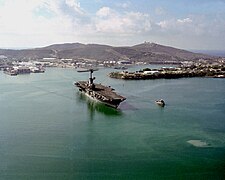
USS Lexington (CV-16)
USS Lexington (CV/CVA/CVS/CVT/AVT-16) is an Essex-class aircraft carrier built during World War II for the United States Navy. Originally intended to be named Cabot, the new aircraft carrier was renamed while under construction to commemorate the recently-lost USS Lexington (CV-2), becoming the sixth U.S. Navy ship to bear the name in honor of the Battle of Lexington.
For other ships with the same name, see USS Lexington.History
Lexington was commissioned in February 1943 and saw extensive service through the Pacific War. For much of her service, she acted as the flagship for Admiral Marc Mitscher, and led the Fast Carrier Task Force through their battles across the Pacific. She was the recipient of 11 battle stars and the Presidential Unit Citation. Following the war, Lexington was decommissioned, but was modernized and reactivated in the early 1950s, being reclassified as an attack carrier (CVA). Later, she was reclassified as an antisubmarine carrier (CVS). In her second career, she operated both in the Atlantic/Mediterranean and the Pacific, but spent most of her time, nearly 30 years, in Pensacola, Florida, as a training carrier (CVT).
Lexington was decommissioned in 1991, with an active service life longer than any other Essex-class ship. Following her decommissioning, she was donated for use as a museum ship in Corpus Christi, Texas. In 2003, Lexington was designated a National Historic Landmark. Though her surviving sister ships Yorktown, Intrepid, and Hornet carry lower hull numbers, Lexington was laid down and commissioned earlier, making Lexington the oldest remaining fleet carrier in the world.
On 26 November 1991, the US Navy turned the Lexington over to the City of Corpus Christi. On 15 June 1992, the ship was donated as a museum and now operates as the "USS Lexington Museum on the Bay" at 2914 North Shoreline Boulevard, Corpus Christi, Texas. A MEGAtheater (similar to IMAX) was added in the forward aircraft elevator space. Lexington was designated a National Historic Landmark in 2003. The ship is carefully maintained, and areas of the ship previously off-limits are becoming open to the public every few years. One of the most recent examples of this is the catapult room.
The ship's World War II-era gun battery is also being partially restored using guns salvaged from scrapped ships. Most notable among these are 5"/38 DP gun turrets saved from the scrapping of the heavy cruiser Des Moines. They have been mounted in the approximate locations where similar mounts once existed as part of the ship's original World War II-era fit. After the coast guard cutter Dauntless' overhaul, her 3"/50cal gun was put on display onboard the Lexington.[20]
On 5 February 2010, the USS Lexington hosted its 17th annual "Stagedoor Canteen".[21]
The National Naval Aviation Museum, at Naval Air Station Pensacola, has a small carrier deck mock-up, whose flight deck is constructed from deck boards salvaged from Lexington.
Popular culture[edit]
In 1975 Lexington served as a filming location at sea the feature movie Midway and again in 1987 for the TV miniseries War and Remembrance. In both cases, she was altered to the extent possible to resemble other vessels, (Yorktown in Midway and Enterprise in War and Remembrance) by adding antiaircraft cannons and operating World War II-vintage Navy aircraft. Lexington was also used (though tied up to her pier) for filming of the 2001 film Pearl Harbor, where she was altered to resemble a Japanese carrier, as well as Hornet.[22]
In July 2007, the popular TV show Ghost Hunters filmed aboard the USS Lexington, looking for evidence of ghosts, and in December 2009, she was the subject of an episode of Ghost Lab, on the Discovery Channel.[23]
In 2014, Pepsi used the ship to film a commercial in preparation for the 2015 Super Bowl. The commercial, titled "Operation Halftime," featured country-music singer Blake Shelton performing for veterans and their families.[24]









